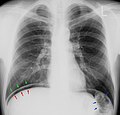Pneumoperitoneum
| Classification according to ICD-10 | |
|---|---|
| K66.8 | Other specified diseases of the peritoneum |
| K66.9 | Disease of the peritoneum, unspecified |
| ICD-10 online (WHO version 2019) | |
A peritoneal cavity (abdominal cavity) filled with air or gas is referred to as a pneumoperitoneum (Pneuma from Greek πνεύμα = air) . If the pneumoperitoneum is created artificially, it is sometimes referred to as the pseudopneumoperitoneum .
causes
The main cause of pneumoperitoneum is perforations (injuries) in the gastrointestinal tract, such as a perforated gastric ulcer . In principle, any part of the digestive tract can be perforated by an ulcer, tumor or trauma . A perforated vermiform appendix in the context of appendicitis only rarely leads to pneumoperitoneum. The penetration of air through the female genital tract is also seen as a cause of spontaneous pneumoperitoneum.
A pneumoperitoneum is usually created artificially for laparoscopic interventions . Using a Veres needle or a trocar to this, carbon dioxide is introduced into the abdominal cavity. This is actually a capnoperitoneum , but is usually also referred to as a pneumoperitoneum. A "gasless" laparoscopy, so-called lift laparoscopy, has not yet become established. In the past, pneumoperitoneum was also triggered artificially ( pneumoperitoneography ) in order to increase the contrast in X-ray diagnostics of the abdominal cavity, but this procedure is now obsolete.
After all surgical interventions with opening of the abdominal cavity, air can be detected in the abdominal cavity for a few days, but this is normal and has no disease value.
Diagnosis
Free gas in the abdominal cavity can be determined by an X-ray examination or a computer tomography , in which even small amounts can be detected. The amount of air in the abdomen can also be detected during ultrasound examinations .
Pneumoperitoneum on chest x-ray . The free "air" can be seen between the upper edge of the liver (red arrows) and the diaphragm (green arrows). The blue arrows point to the gas-filled colon (normal).
If, in addition to the free air in the abdomen, there is also free fluid, the result is mirror formation (arrow).
Pneumoperitoneum on an x-ray in a patient lying on their left side. The free "air" in the abdominal cavity (green arrows) collects above the liver (red arrows on the edge of the liver). If there is free fluid in the abdominal cavity, an air-fluid level forms (blue arrows).
therapy
In cases of abnormal pneumoperitoneum, treatment is based on the cause, with injuries closed and tumors removed.
A pneumoperitoneum can also be used as a treatment measure itself. Historically, this was the case in the treatment of intestinal tuberculosis . In some cases, a pneumoperitoneum according to Moreno is used as a pretreatment before the operation of large hernias to allow abdominal organs to slide out of the hernial sac.
literature
- Raul J Rosenthal, Richard L Friedman, Edward H Phillips: The Pathophysiology of Pneumoperitoneum. Springer, Berlin 1997, ISBN 3-540-63015-5 .
- B. Boehm, W. Schwenk, T. Junghans: The Pneumoperitoneum. Springer, Berlin 2000, ISBN 3-540-66740-7 .
Web links
Individual evidence
- ^ Ali Nawaz Khan: Pneumoperitoneum. eMedicine.com.
- ↑ Daniel Kruschinski: The Pneumoperitoneum - The Cardinal Error in Laparoscopy? (PDF; 654 kB).
- ↑ Vittorio Paolucci: gasless laparoscopy in General Surgery and Gynecology: Diagnosis - Operational Procedures. Thieme, 1996, ISBN 0-86577-604-0 .
- ↑ Robert Klopstock, Wilfrid Schüler: The Pneumoperitoneum as a treatment method for intestinal tuberculosis. In: Lung. 83 (1933), pp. 1-9, doi: 10.1007 / BF02141640 .
- ^ M. Weinrich, S. Richter, S. Scheingraber, C. Justinger, Martin K Schilling: The progressive pneumoperitoneum according to Moreno - a good exception indication for extensive abdominal wall hernias. ( Memento of the original from August 4, 2016 in the Internet Archive ) Info: The archive link was inserted automatically and has not yet been checked. Please check the original and archive link according to the instructions and then remove this notice. (PDF; 9 kB) Lecture at the summer conference of the Association of Northwest German Surgeons, 2007.
- ↑ M. Henrich: Preoperative Pneumoperitoneum for the treatment of large abdominal wall hernias. In: Langenbeck's Archives of Surgery. 361 (1983), pp. 337-339, doi: 10.1007 / BF01275880 .


